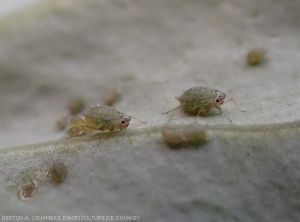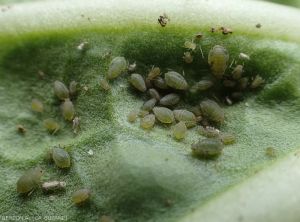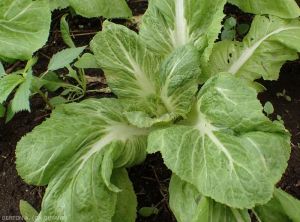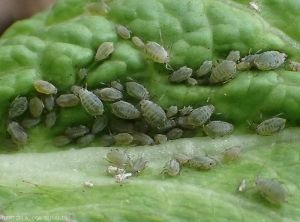Turnip aphid
Lipaphis erysimi
General
- Aphid widely distributed throughout the world and native to Europe.
- Also present in tropical to temperate climate zones.
- Occasionally encountered on cabbage leaves.
- A vector of several viruses, including turnip mosaic virus and cauliflower mosaic virus.
- Observed in the open field as well as under shelters.
- Sensitive botanical family (s)
- Affected production areas :
| Mayotte |
Reunion |
Guyana |
| Guadeloupe |
Martinique |
New Caledonia |
| French Polynesia |
|
|
Symptoms, damage
- Aphids generally located on the underside of leaves, on both sides of cabbage leaves in the event of outbreaks
- Leaf curling and curling.
- General weakening of plants in case of high population.
- production of honeydew on the limb causing the appearance of sooty mold.
Biology
- Reproduction by parthenogenesis, without fertilization. Larvae or eggs are directly produced by adult females.
- Each female produces 80 to 100 aphids at a rate of 4 to 6 larvae per day.
- The lifespan of the female varies from 20 to 40 days.
- Measuring 1.4 and 2.5 mm long, the aphids have brown cornicles, and are yellow-green to dark gray in color.
- The winged forms are visible when the colony becomes important.
Protection
- Weed the crop and its surroundings.
- Check the sanitary quality of the plants before and during their introduction into the crop or shelter.
- Proper management of fertilization by limiting excess inputs limits the susceptibility of plants to attacks by aphids and other pests.
- Plant cabbage sheltered from the wind to avoid contamination between plots.
- Destroy contaminated crop residues after harvest.
- Crop rotations without brassicas should reduce the presence of the pest that is confined to this botanical family.

Figure 1

Figure 2

Figure 3

Figure 4

Figure 5

Figure 6






